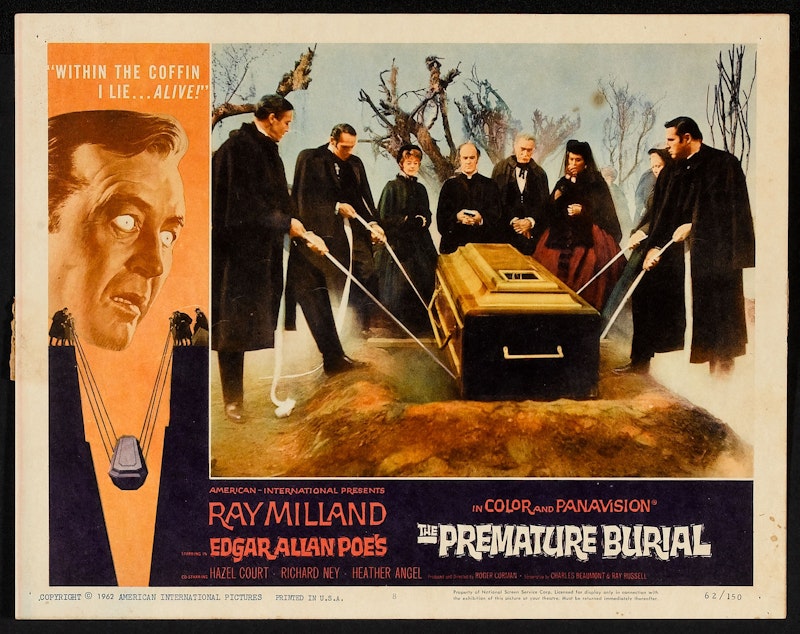Roger Corman directed two successful film adaptations of Edgar Allan Poe stories by 1962, so it’s not surprising he returned to the same well that year for his next film. The specific choice of tale is more surprising. Poe’s “The Premature Burial” is a mood piece, a meditation on the idea of being buried alive, ending with a strange anecdote. Corman’s The Premature Burial has to invent its entire storyline. Yet the movie manages to preserve something of the morbid, uncanny atmosphere of Poe’s text.
And that’s despite some production oddities. Corman had a dispute with American International Pictures, with whom he’d made House of Usher and The Pit and the Pendulum, over his share of the profits from those films. So he decided to make Premature Burial independently, with financial backing from Pathé Lab. AIP then bought the production from Pathé. But its independent origin meant one big change from the other movies: since Vincent Price was under contract to AIP, Corman hired Ray Milland as his star.
Milland, an Oscar-winning actor who claimed not to enjoy acting, was coming off a couple of brief retirements interrupted by TV work. Here he plays Guy Carrell, a rich British doctor in the 19th century who has a family history of catalepsy and a terror of being buried alive. The movie opens with his fiancée Emily (Hazel Court) coming to his isolated family mansion; Guy’s broken off their engagement after his fears were triggered by a recent grave robbery. Emily’s determined to marry him nevertheless, despite the reservations of Guy’s sister Katie (Heather Angel).
They do marry, but a series of seemingly unrelated events worsen Guy’s obsession. He builds a fantastic mausoleum filled with comforts and escape routes. Emily and his friend Miles Archer (Richard Ney) try to return him to sanity, but an unfortunate relapse triggers a conclusion of madness, murder, and unexpected but well-foreshadowed plot twists.
The script comes from horror writers Charles Beaumont and Ray Russell, stepping in for Beaumont’s fellow Twilight Zone scribe Richard Matheson, who wrote Corman’s previous Poe adaptations. The plot has some of the same characteristics of Matheson’s expansions of Poe’s work: an atmospheric first hour, a complex central male figure alternately sympathetic and fearsome, an isolated house (in this case, with a surrounding estate), and above all a sense of incipient madness.
It’s a structure that acts as a framework in which Corman’s direction can catch some of the tones of Poe’s work. The relative slowness of the first two-thirds of the film, with no monsters or murders, works because viewers are still led to brood on being buried alive, just as Guy does, and as Poe did. In particular, there’s a striking dialogue-free dream sequence near the middle of the film that lets Corman visually evoke the terror of the grave.
Dreamlike prose inspires dream sequences and characters tottering on the edge of rationality: Corman’s Poe films succeed as adaptations as well as tales in their own right by finding dramatic and cinematic shapes for stories that used other approaches. The mechanisms of conflict and resolution devised by Corman and his scriptwriters let Poe’s weirdness in because the characters are inspired by the weirdness of the stories.
Here we get a protagonist obsessed with premature burial, as the narrator of Poe’s story was. The idea of being buried alive turns up several times in Poe’s work, as does a blurring of the boundaries between life and death. And these things turn up repeatedly in Corman’s adaptations, too, though it’s not obvious that Corman’s as concerned with them as Poe. It’s just that the recurring plot structures of the films echo Poe’s obsessions.
The recurring imagery of Corman’s movies helps. The houses and castles are shot on the same sets with the same props, but they’re reworked so that each of the isolated gothic structures feels slightly different. Premature Burial gives us a wooded estate and a bizarre mausoleum, and so is a small visual expansion to the Poe cycle.
Milland brings some variety of his own, a younger and more uncertain figure than Price. He’s the key to the movie. His madness has to be interesting for the story to work. It’s not realistic acting, but it is a charismatic performance of a character who isn’t traditionally charismatic. Guy Carrell could’ve come off as weak, and that would have killed the film. Instead you get a sense of a man struggling with something no-one else can see. It’s haunting, and touches a kind of tragedy.
As Milland builds his character the plot gets increasingly feverish, so that the end has a feel like a Universal horror movie. There’s violence, and a graveyard at night, and a mad rush of action and betrayal. It’s a satisfying payoff, because it’s an extension of character and theme. It’s not sophisticated, but it’s solid craftsmanship. The movie builds to its moments of horror through a series of darker tones, and when it comes, it works.
The horror in The Premature Burial is madness, and specifically the madness that comes from facing mortal corruption and the unyielding nature of the universe. Corman’s earlier Poe films are similar—different movies, but ones that look at similar themes from different angles. There’s a formula to them, but a formula that works artistically.

